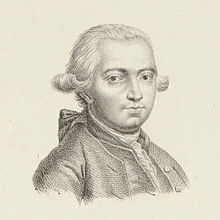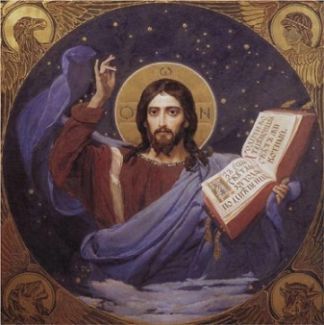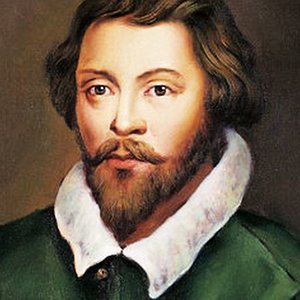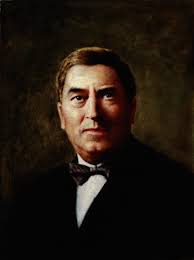The Two Great Commandments
Mount Calvary Church
A Roman Catholic Congregation of
The Personal Ordinariate of the Chair of St. Peter
Anglican Use
Trinity XX
Hymns
Come, Thou almighty King
Draw near and take the Body of the Lord
O God, our help in ages past
Anthems
A new commandment, Thomas Tallis
Ubi caritas, Maurice Duruflé
Common
Missa de S. Maria Magdalena, Willan
____________________
Hymns
Come, Thou Almighty King is by an unknown author and predates 1757. Similarities between “Come, Thou Almighty King” and the British national anthem “God Save the King” suggest that the hymn was written as a parody to that national anthem. There is a story that, during the American Revolution, some British soldiers surprised an American congregation on Long Island and ordered them to sing “God Save the King.” The Americans responded by singing the correct tune, but the words of “Come, Thou Almighty King.”
In his first letter to Timothy, the apostle Paul warns him that the Christian life is a constant war against evil. He commands Timothy to “Fight the good fight of the faith” (1 Timothy 6:12). A few verses later, Paul describes the one for whose sake we fight: “He who is the blessed and only Sovereign, the King of kings and Lord of lords, who alone has immortality, who dwells in unapproachable light, whom no one has ever seen or can see. To Him be honor and eternal dominion. Amen” (1 Timothy 6:15-16). In this hymn, we praise God as our King and Ruler, addressing each Person of the Trinity in turn, and end with a request that “His Sovereign majesty / May we in glory see.”
1 Come, Thou Almighty King,
help us Thy name to sing,
help us to praise:
Father, all glorious,
o’er all victorious,
come and reign over us,
Ancient of Days.
2 Come, Thou Incarnate Word,
gird on Thy mighty sword,
our pray’r attend;
Come, and Thy people bless,
and give Thy Word success:
Spirit of holiness,
on us descend.
3 Come, Holy Comforter,
Thy sacred witness bear
in this glad hour:
Thou who almighty art,
now rule in ev’ry heart,
and ne’er from us depart,
Spirit of pow’r.
4 To the great One in Three,
eternal praises be
hence evermore.
His sov’reign majesty
may we in glory see,
and to eternity
love and adore.
The tune MOSCOW was composed by Felice Giardini, who born in Turin. When it became clear that he was a child prodigy, his father sent him to Milan. There he studied singing, harpsichord and violin but it was on the latter that he became a famous virtuoso. By the age of 12, he was already playing in theater orchestras. In a famous incident about this time, Giardini, who was serving as assistant concertmaster (i.e. leader of the orchestra) during an opera, played a solo passage for violin which the composer Niccolò Jommelli had written. He decided to show off his skills and improvised several bravura variations which Jommelli had not written. Although the audience applauded loudly, Jommelli, who happened to be there, was not pleased and suddenly stood up and slapped the young man in the face. Giardini, years later, remarked, “it was the most instructive lesson I ever received from a great artist.”

During the 1750s, Giardini toured Europe as a violinist, scoring successes in Paris, Berlin, and especially in England, where he eventually settled. For many years, he served as the orchestra leader and director of the Italian Opera in London and gave solo concerts under the auspices of J. C. Bach with whom he was a close friend. He directed the orchestra at the London Pantheon. From the mid-1750s to the end of the 1760s, he was widely regarded as the greatest musical performing artist before the public. His identity with the Signor Giardini, who in 1774 sought with Dr Charles Burney to form a public music school associated with the Foundling Hospital is uncertain. In 1784, he returned to Naples to run a theater, but encountered financial setbacks. In 1793, he returned to England to try his luck. But times had changed, and he was no longer remembered. He then went to Russia, but again had little luck, dying in Moscow in 1796.
Giardini was a prolific composer, writing for virtually every genre which then existed. His two main areas, however, were opera and chamber music. Virtually all of his music is out of print with the exception of a few songs and works of chamber music. As a string player, he knew how to make string instruments sound their best. His chamber music combines the so-called Style Galant with the mid-18th-century classicism of J.C. Bach, the Stamitzes and the Mannheim school. In the Style Galant, the writing emphasizes the soloistic qualities of the instruments, rather than integrated part-writing, to create a whole. Giardini, although he did write string quartets and quartets for other instruments — a new and evolving form at the time — concentrated on writing trios, primarily those for violin, viola and cello, of which he wrote at least 18.
Giardini is known among Protestant churches for his “Italian Hymn” or “Moscow”, which often accompanies the text to the hymn “Come, Thou Almighty King” and also John Marriott’s hymn “Thou whose almighty word”.
_______________________
Draw nigh and take the Body of the Lord is a translation by the Anglican clergyman John Mason Neale (1818—1866) of the seventh-century Latin hymn Sancti venite, corpus Christi sumite. From a devout Evangelical family, Neale attended Cambridge, which like Oxford was influenced by the revival of Catholicism.
The hymn begins with the New Testament understanding of Psalm 34:8: “Oh, taste and see that the LORD is good! Blessed is the man who takes refuge in Him!” The only way to “taste and see that the LORD is good” is to “draw near and take the body of the Lord.” Jesus gives us His body and blood to taste God’s goodness. In God’s goodness, He rules and shields His saints. He gives everlasting life with heavenly bread and living water.
1 Draw nigh and take the Body of the Lord,
And drink the holy Blood for you outpoured.2 Saved by that Body and that holy Blood,
With souls refreshed, we render thanks to God.3 Salvation’s giver, Christ, the only Son,
By His dear cross and Blood the victory won.4 Offered was He for greatest and for least
Himself the Victim, and Himself the Priest.5 Victims were offered by the law of old,
That in a type celestial mysteries told.6 He, Ransomer from death, and Light from shade
Now gives His holy grace, His saints to aid.7 Approach ye then with faithful hearts sincere,
And take the safeguard of salvation here.8 He, that His saints in this world rules and shields,
To all believers life eternal yields;9 With heavenly bread makes them that hunger whole,
Gives living waters to the thirsting soul.10 Alpha and Omega, to Whom shall bow
All nations at the doom, is with us now.
Here is the Latin hymn:
Sancti venite, Christi corpus sumite,
Sanctum bibentes, quo redempti sanguinem.Salvati Christi corpore et sanguine,
A quo refecti laudes dicamus Deo.Hoc sacramento corporis et sanguinis
Omnes exuti ab inferni faucibus.Dator salutis, Christus filius Dei,
Mundum salvavit per crucem et sanguinem.Pro universis immolatus Dominus
Ipse sacerdos exstitit et hostia.Lege praeceptum immolari hostias,
Qua adumbrantur divina mysteria.Lucis indultor et salvator omnium
Praeclaram sanctis largitus est gratiam.Accedant omnes pura mente creduli,
Sumant aeterman salutis custodiam.Sanctorum custos, rector quoque,
Dominus, Vitae perennis largitor credentibus.Caelestem panem dat esurien- tibus,
De fonte vivo praebet sitientibus.Alpha et omega ipse Christus Dominus
Venit, venturus iudicare homines
“Sancti venite” was composed at Bangor Abbey in the 7th century AD, making it the oldest known Eucharistic hymn. It was carried to Bobbio Abbey and was first published by Ludovico Antonio Muratori in his Anecdota Latina ex Ambrosianæ Bibliothecæ codicibus (1697–98), when he discovered it in the Biblioteca Ambrosiana. According to a legend recorded in An Leabhar Breac, the hymn was first sung by angels at St. Seachnall’s Church, Dunshaughlin, after Secundinus had reconciled with his uncle Saint Patrick.
______________________
O God, our help in ages past. Considered one of the finest paraphrases written by Isaac Watt (1674—1748), the hymn expresses a strong note of assurance, promise, and hope in the LORD as recorded in the first part of Psalm 90. It contrasts the ephemeral quality of human life with the unshakeable eternity of God.
Watts is often called the “Father of English hymnody”—that is, hymns on a wider range of topics rather than metrical versions of the psalms in the English language. Before him, congregational song focused almost exclusively on singing strict metrical versions of the psalms.
1 Our God, our Help in ages past,
our Hope for years to come,
our Shelter from the stormy blast,
and our eternal Home.
2 Under the shadow of Thy throne
Thy saints have dwelt secure;
sufficient is Thine arm alone,
and our defense is sure.
3 Before the hills in order stood
or earth received its frame,
from everlasting Thou art God,
to endless years the same.
4 A thousand ages in Thy sight
are like an ev’ning gone,
short as the watch that ends the night
before the rising sun.
5 Time, like an ever-rolling stream,
bears all its sons away;
they fly forgotten, as a dream
dies at the op’ning day.
6 Our God, our Help in ages past,
our Hope for years to come,
be Thou our Guide while life shall last,
and our eternal Home!
Here is the hymn at Westminster Abbey.
The hymn tune “St. Anne” was composed by William Croft in 1708 while he was the organist of the church of St. Anne, Soho. J. S. Bach’s Fugue in E-flat major BWV 552 is often called the “St. Anne” because of the similarity of its subject to the first line of the hymn tune, though there is some debate as to whether Bach used the actual tune after hearing it, or coincidentally created the very similar tune used as the fugal theme.
Here is Bach’s fugue.
____________________________
Anthems
A new commandment, Thomas Tallis
A new commandment give I unto you, saith the Lord, that ye love together, as I have loved you, that even so ye love one another. By this shall every man know that ye are my disciples, if ye have love one to another.
Here are three voices.
Little is known about Thomas Tallis’s early life, but there seems to be agreement that he was born in the early 16th century, toward the close of the reign of Henry VII. Little is also known about Tallis’s childhood and his significance with music at that age. However, there are suggestions that he was a Child (boy chorister) of the Chapel Royal, St. James’ Palace, the same singing establishment which he later joined as a Gentleman. His first known musical appointment was in 1532, as organist of Dover Priory (now Dover College), a Benedictine priory in Kent. His career took him to London, then (probably in the autumn of 1538) to Waltham Abbey, a large Augustinian monastery in Essex which was dissolved in 1540. Tallis was paid off and also acquired a volume and preserved it; one of the treatises in it, by Leonel Power, prohibits consecutive unisons, fifths, and octaves.
Tallis’s next post was at Canterbury Cathedral. He was next sent to Court as Gentleman of the Chapel Royal in 1543 (which later became a Protestant establishment), where he composed and performed for Henry VIII,[9] Edward VI (1547–1553), Queen Mary (1553–1558), and Queen Elizabeth I (1558 until Tallis died in 1585). Throughout his service to successive monarchs as organist and composer, Tallis avoided the religious controversies that raged around him, though, like William Byrd, he stayed an “unreformed Roman Catholic.” Tallis was capable of switching the style of his compositions to suit the different monarchs’ vastly different demands. Among other important composers of the time, including Christopher Tye and Robert White, Tallis stood out. Walker observes, “He had more versatility of style than either, and his general handling of his material was more consistently easy and certain.” Tallis was also a teacher, not only of William Byrd, but also of Elway Bevin, an organist of Bristol Cathedral, and Gentleman of the Chapel Royal.
Tallis married around 1552; his wife, Joan, outlived him by four years. They apparently had no children. Late in his life he lived in Greenwich, possibly close to the royal palace: a local tradition holds that he lived on Stockwell Street.
Queen Mary granted Tallis a lease on a manor in Kent that provided a comfortable annual income. In 1575, Queen Elizabeth granted to him and William Byrd a 21-year monopoly for polyphonic music and a patent to print and publish music, which was one of the first arrangements of that type in the country. Tallis’s monopoly covered ‘set songe or songes in parts’, and he composed in English, Latin, French, Italian, or other tongues as long as they served for music in the Church or chamber. Tallis had exclusive rights to print any music, in any language. He and William Byrd were the only ones allowed to use the paper that was used in printing music. Tallis and Byrd used their monopoly to produce Cantiones quae ab argumento sacrae vocantur in 1575, but the collection did not sell well and they appealed to Queen Elizabeth for her support. People were naturally wary of their new publications, and it certainly did not help their case that they were both avowed Roman Catholics. Not only that, they were strictly forbidden to sell any imported music. “We straightly by the same forbid…to be brought out of any forren Realmes…any songe or songes made and printed in any foreen countrie.” Also, Byrd and Tallis were not given “the rights to music type fonts, printing patents were not under their command, and they didn’t actually own a printing press.”
Tallis retained respect during a succession of opposing religious movements and deflected the violence that claimed Catholics and Protestants alike. He died peacefully in his house in Greenwich in November 1585.
___________________________
Ubi caritas, Maurice Duruflé
Ubi caritas et amor, Deus ibi est. Congregavit nos in unum Christi amor. Exultemus, et in ipso iucundemur. Timeamus, et amemus Deum vivum. Et ex corde diligamus nos sincero.
Where charity and love are, God is there. Christ’s love has gathered us into one. Let us rejoice and be pleased in Him. Let us fear, and let us love the living God. And may we love each other with a sincere heart.
Here is the King’s College Choir, Cambridge.
Maurice Duruflé’s choral setting makes use of the Gregorian melody, using only the words of the refrain and the first stanza.
Ubi caritas is a hymn of the Western Church, long used as one of the antiphons for the washing of feet on Maundy Thursday. The Gregorian melody was composed sometime between the fourth and tenth centuries, though some scholars believe the text dates from early Christian gatherings before the formalization of the Mass. It is usually sung at Eucharistic Adoration and Benediction of the Blessed Sacrament and on Holy Thursday evening at the Mass of the Lord’s Supper.
Ubi caritas et amor, Deus ibi est.
Congregavit nos in unum Christi amor.
Exsultemus, et in ipso jucundemur.
Timeamus, et amemus Deum vivum.
Et ex corde diligamus nos sincero.
Ubi caritas et amor, Deus ibi est.
Simul ergo cum in unum congregamur:
Ne nos mente dividamur, caveamus.
Cessent iurgia maligna, cessent lites.
Et in medio nostri sit Christus Deus.
Ubi caritas et amor, Deus ibi est.
Simul quoque cum beatis videamus,
Glorianter vultum tuum, Christe Deus:
Gaudium quod est immensum, atque probum,
Saecula per infinita saeculorum. Amen.
Maurice Duruflé was born in Louviers, Eure in 1902. He became a chorister at the Rouen Cathedral Choir School from 1912 to 1918, where he studied piano and organ with Jules Haelling, a pupil of Alexandre Guilmant. The choral plainsong tradition at Rouen became a strong and lasting influence. At age 17, upon moving to Paris, he took private organ lessons with Charles Tournemire, whom he assisted at Basilique Ste-Clotilde, Paris until 1927. In 1920 Duruflé entered the Conservatoire de Paris, eventually graduating with first prizes in organ with Eugène Gigout (1922), harmony with Jean Gallon (1924), fugue with Georges Caussade (1924), piano accompaniment with César Abel Estyle (1926) and composition with Paul Dukas (1928).
In 1927, Louis Vierne nominated him as his assistant at Notre-Dame. Duruflé and Vierne remained lifelong friends, and Duruflé was at Vierne’s side acting as assistant when Vierne died at the console of the Notre-Dame organ on 2 June 1937, even though Duruflé had become titular organist of St-Étienne-du-Mont in Paris in 1929, a position he held for the rest of his life. In 1930 he won a prize for his “Prélude, adagio et choral varié sur le “Veni Creator”, and in 1936 he won the Prix Blumenthal. In 1939, he premiered Francis Poulenc’s Organ Concerto (the Concerto for Organ, Strings and Timpani in G minor); he had advised Poulenc on the registrations of the organ part. In 1943 he became Professor of Harmony at the Conservatoire de Paris, where he worked until 1970; among his pupils were Pierre Cochereau, Jean Guillou and Marie-Claire Alain.
In 1947 he completed probably the most famous of his few pieces: the Requiem op. 9, for soloists, choir, organ, and orchestra. He had begun composing the work in 1941, following a commission from the Vichy regime. Also in 1947, Marie-Madeleine Chevalier became his assistant at St-Étienne-du-Mont. They married on 15 September 1953. (Duruflé’s first marriage to Lucette Bousquet, in 1932, ended in civil divorce in 1947 and was declared null by the Vatican on 23 June 1953.) The couple became a famous and popular organ duo, going on tour together several times throughout the sixties and early seventies.
He was made a Chevalier de la Legion d’honneur in 1954. He was promoted to an Officier de la Legion d’honneur in 1966.
Duruflé suffered severe injuries in a car accident on 29 May 1975, and as a result he gave up performing; indeed he was largely confined to his apartment, leaving the service at St-Étienne-du-Mont to his wife Marie-Madeleine (who was also injured in the accident). He died in Louveciennes (near Paris) in 1986, aged 84.


